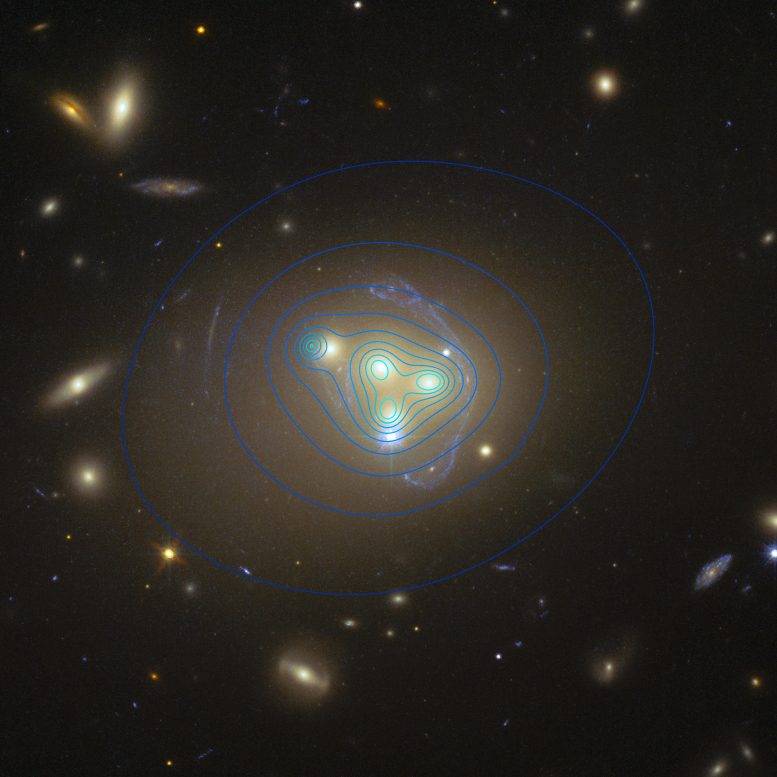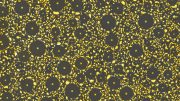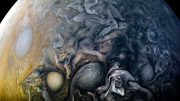
This image from the NASA/ESA Hubble Space Telescope shows the rich galaxy cluster Abell 3827. The strange pale blue structures surrounding the central galaxies are gravitationally lensed views of a much more distant galaxy behind the cluster. The distribution of dark matter in the cluster is shown with blue contour lines. The dark matter clump for the galaxy at the left is significantly displaced from the position of the galaxy itself, possibly implying dark matter-dark matter interactions of an unknown nature are occurring. Credit: ESO/R. Massey
Using new Hubble Space Telescope imaging and VLT/MUSE integral field spectroscopy, astronomers reveal what may be the first signs of self-interacting dark matter.
For the first time dark matter may have been observed interacting with other dark matter in a way other than through the force of gravity. Observations of colliding galaxies made with ESO’s Very Large Telescope and the NASA/ESA Hubble Space Telescope have picked up the first intriguing hints about the nature of this mysterious component of the Universe.
Using the MUSE instrument on ESO’s VLT in Chile, along with images from Hubble in orbit, a team of astronomers studied the simultaneous collision of four galaxies in the galaxy cluster Abell 3827. The team could trace out where the mass lies within the system and compare the distribution of the dark matter with the positions of the luminous galaxies.
Although dark matter cannot be seen, the team could deduce its location using a technique called gravitational lensing. The collision happened to take place directly in front of a much more distant, unrelated source. The mass of dark matter around the colliding galaxies severely distorted spacetime, deviating the path of light rays coming from the distant background galaxy — and distorting its image into characteristic arc shapes.
Our current understanding is that all galaxies exist inside clumps of dark matter. Without the constraining effect of dark matter’s gravity, galaxies like the Milky Way would fling themselves apart as they rotate. In order to prevent this, 85 percent of the Universe’s mass [1] must exist as dark matter, and yet its true nature remains a mystery.
In this study, the researchers observed the four colliding galaxies and found that one dark matter clump appeared to be lagging behind the galaxy it surrounds. The dark matter is currently 5000 light-years (50,000 million million kilometers) behind the galaxy — it would take NASA’s Voyager spacecraft 90 million years to travel that far.
A lag between dark matter and its associated galaxy is predicted during collisions if dark matter interacts with itself, even very slightly, through forces other than gravity [2]. Dark matter has never before been observed interacting in any way other than through the force of gravity.
Lead author Richard Massey at Durham University, explains: “We used to think that dark matter just sits around, minding its own business, except for its gravitational pull. But if dark matter were being slowed down during this collision, it could be the first evidence for rich physics in the dark sector — the hidden Universe all around us.”
The researchers note that more investigation will be needed into other effects that could also produce a lag. Similar observations of more galaxies, and computer simulations of galaxy collisions will need to be made.
This video using images from the NASA/ESA Hubble Space Telescope shows the rich galaxy cluster Abell 3827. The strange blue structures surrounding the central galaxies are gravitationally lensed views of a much more distant galaxy behind the cluster. Observations of the central four merging galaxies have provided hints that the dark matter around one of the galaxies is not moving with the galaxy itself, possibly implying dark matter-dark matter interactions of an unknown nature are occurring. Credit: NASA, ESA. Music: Johan B. Monell
Team member Liliya Williams of the University of Minnesota adds: “We know that dark matter exists because of the way that it interacts gravitationally, helping to shape the Universe, but we still know embarrassingly little about what dark matter actually is. Our observation suggests that dark matter might interact with forces other than gravity, meaning we could rule out some key theories about what dark matter might be.”
This result follows on from a recent result from the team which observed 72 collisions between galaxy clusters [3] and found that dark matter interacts very little with itself. The new work however concerns the motion of individual galaxies, rather than clusters of galaxies. Researchers say that the collision between these galaxies could have lasted longer than the collisions observed in the previous study — allowing the effects of even a tiny frictional force to build up over time and create a measurable lag [4].
Taken together, the two results bracket the behavior of dark matter for the first time. Dark matter interacts more than this, but less than that. Massey added: “We are finally homing in on dark matter from above and below — squeezing our knowledge from two directions.”
Notes
[1] Astronomers have found that the total mass/energy content of the Universe is split in the proportions of 68% dark energy, 27% dark matter, and 5% “normal” matter. So the 85% figure relates to the fraction of “matter” that is dark.
[2] Computer simulations show that the extra friction from the collision would make the dark matter slow down. The nature of that interaction is unknown; it could be caused by well-known effects or some exotic unknown force. All that can be said at this point is that it is not gravity.
All four galaxies might have been separated from their dark matter. But we happen to have a very good measurement from only one galaxy, because it is by chance aligned so well with the background, gravitationally lensed object. With the other three galaxies, the lensed images are further away, so the constraints on the location of their dark matter are too loose to draw statistically significant conclusions.
[3] Galaxy clusters contain up to a thousand individual galaxies.
[4] The main uncertainty in the result is the timespan for the collision: the friction that slowed the dark matter could have been a very weak force acting over about a billion years, or a relatively stronger force acting for “only” 100 million years.
Reference: “The behaviour of dark matter associated with four bright cluster galaxies in the 10 kpc core of Abell 3827” by Richard Massey, Liliya Williams, Renske Smit, Mark Swinbank, Thomas D. Kitching, David Harvey, Mathilde Jauzac, Holger Israel, Douglas Clowe, Alastair Edge, Matt Hilton, Eric Jullo, Adrienne Leonard, Jori Liesenborgs, Julian Merten, Irshad Mohammed, Daisuke Nagai, Johan Richard, Andrew Robertson, Prasenjit Saha, Rebecca Santana, John Stott and Eric Tittley, 9 April 2015, MNRAS.
DOI: 10.1093/mnras/stv467
arXiv: 1504.03388









There is no “Dark matter”. The observation is the effect of Lorentz forces on Galaxy’s, F=eVxB. the forc consists of intergalactic electron flow eV crossing with the Magnetic B-field created by the rotation of charged suns, B=uI/r. The force is F= PxV/r=eVxB . Without electron flow eV, the rotation would be consistent gravity rotation, slow rotation. However, when the electron flows in there is an extra eVxB=VxP/r giving
mV=P=eBr=euI and V=(e/m)UI= 176Gx1.25uxI= 220Im/s = 220km/s when I=1Amp.
The rotation of the charged suns rotating sufficiently to create 1 amp will raise the gravitation rate to 220km/s !
Electrons escape (speed) from hot suns, leaving positive suns and galaxies.
Intergalactic electrons seek positive galaxies.
Galaxies rotating in the same direction attract each other, opposite rotations repel each other.
The “Dark Matter” effect is really Dark Energy; P=euI=ezI/c thus, cP=ezI the Dark Energy! cP is the Dark Energy, unrecognized by Physicists, because “Energy is not supposed to be a VECTOR” as cP is!
Energy is a Quaternion, a scalar=V.P and a Vector=cP=cmV.
Energy is W=[c,V][0,P] = [-v.p, cP]
The best solution would dark matter forming a neutral plane of three phasors ejections forming Four clusters making a mobility chra radi immobility sthiram as fixed and upayam as crab dynamical bor combinational mobile and immobile dynamics requiring NASA research frming fire erath air water seprations i between squeezing the freq uency wqve lengh convergence along the plane of hologram source with Blackhole back up as a special Hawking-Roger penrose-Sankravelayudhan Nandakumar radiations
@Wardell: Your post makes absolutely no sense. You obviously don’t understand the equations that you pepper your post with, and the way an electromagnetic field operates. In fact, your post is so far off the mark, that it is not even worth pointing out the mistakes.
… are there different types of dark matter?
… I think like a different flavourz of dark matter, like more types!